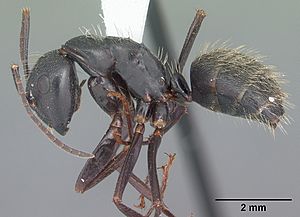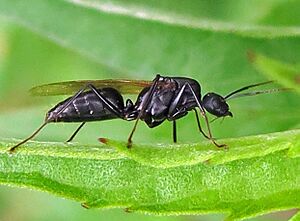Black carpenter ant facts for kids
Quick facts for kids Black carpenter ant |
|
|---|---|
 |
|
| Camponotus pennsylvanicus worker | |
| Scientific classification | |
| Kingdom: | |
| Phylum: | |
| Class: | |
| Order: | |
| Family: | |
| Subfamily: |
Formicinae
|
| Genus: | |
| Species: |
C. pennsylvanicus
|
| Binomial name | |
| Camponotus pennsylvanicus (De Geer, 1773)
|
|
Camponotus pennsylvanicus, also known as the black carpenter ant, is a large and common type of carpenter ant. You can find these ants in the central and eastern United States, as well as eastern Canada.
Contents
What Do Black Carpenter Ants Look Like?
Black carpenter ants are easy to spot because they are mostly dull black. They often have whitish or yellowish hairs on their lower body, called the abdomen. All the different types of ants in a colony, like workers, queens, and males, are black or very dark.
These ants come in different sizes. This is called being polymorphic. The queen ants are the biggest, growing up to 19–21 mm long. The largest worker ants, sometimes called "super majors," can be almost as big, reaching about 14–17 mm. Black carpenter ants are among the biggest ants in North America! Like all ants, their antennae are bent like an elbow. Worker ants usually have 12 parts to their antennae. Flying ants, called alates, typically have yellowish wings.
How Do Black Carpenter Ants Behave?
Black carpenter ants are always on the move looking for food. They can travel up to 91 meters (about 100 yards) from their nest! As they search, they leave behind special chemical trails called pheromones. These trails help other ants find their way to food sources.
A single nest can hold thousands of ants. When a nest is very large, you might even hear a soft cracking sound made by the workers. Black carpenter ants cannot sting you. However, the larger worker ants can give a painful bite. To make it worse, they might spray formic acid onto the bite.
Smaller worker ants often take care of aphids, which are tiny insects. They collect a sweet liquid called honeydew from the aphids. Then, they transfer this honeydew to larger workers. These bigger ants carry the honeydew back to the nest for the colony to eat. Black carpenter ants also eat dead insects and plant juices.
Where Do Black Carpenter Ants Live?
You can find black carpenter ants almost everywhere east of the Rocky Mountains. They prefer to live in woodlands, along the edges of forests, and even in suburban neighborhoods.
Why Are Black Carpenter Ants Sometimes Pests?
In nature, carpenter ants build their nests inside dead trees and other dead wood. This helps the wood break down, which is good for the environment. However, these ants can become a problem if they move into the wood of a house or other building. They can damage the structure by creating tunnels.
Carpenter ants prefer wood that is moist. So, to keep them away, it's important to fix anything that causes wood to get wet. For example, make sure your gutters are clear. This stops water from running down your house or getting inside. Wet wood is much easier for ants to chew through.
The ants don't actually eat the wood. Instead, they chew it away to create tunnels and rooms for their colony. These tunnels, called galleries, usually run parallel to the wood grain. They are made in the softer parts of the wood. If you touch these galleries, they might feel rough, like sandpaper, because of tiny bits of ant waste. This is different from termites, which create mud tubes.


